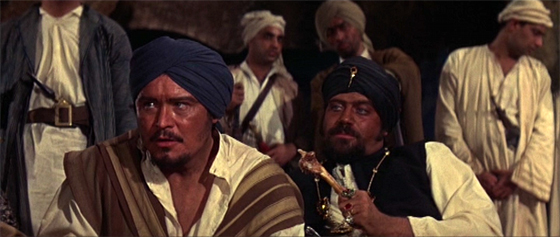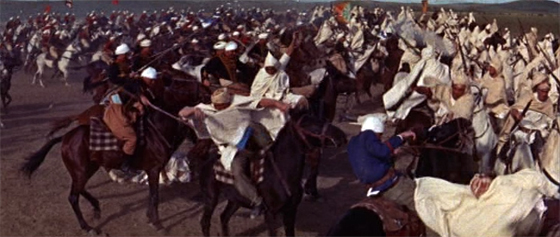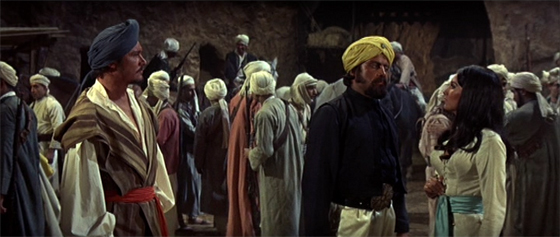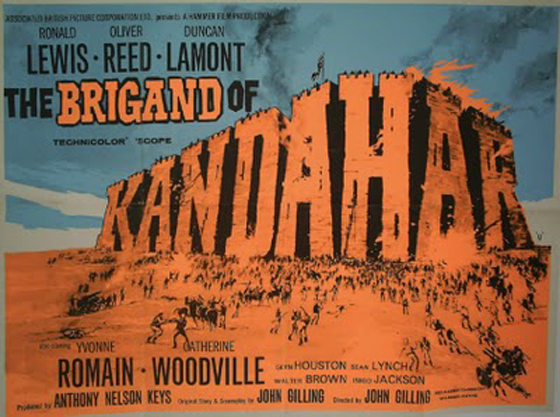
I’m sure Hammer would have loved to have had a David Lean in their stable of directors. They craved prestige. She (1965) took them furthest in the direction of big-budget adventure spectacle, and it was enough of a hit to justify a shoddier sequel and a few would-be epics, among them the sensationalistic The Viking Queen (1967). The Brigand of Kandahar was released the same year as She, but the budget was tighter, and it shows. You get the feeling they wanted to get a quickie epic in the can to puff up their resumé. But Brigand can’t compete with Lawrence of Arabia, made just three years earlier. It’s a 78-minute B-movie, and a somewhat limp end to Hammer’s co-production deal with Columbia Pictures, who had helped finance and distribute many Hammer classics through the early 60’s. John Gilling of The Scarlet Blade (1963) wrote and directed, recycling footage (and plot) from the 1956 British Colonialist adventure film Zarak, a Terence Young film for which Gilling was associate director. This accounts for the unusually large-scale battle scenes which close the film – and also for a few awkward moments in which Gilling clumsily foregrounds his actors before rear-projection of Zarak action. This is Hammer moving dangerously close to Roger Corman territory.

No, we couldn't really afford this: Recycled "Zarak" footage in "The Brigand of Kandahar."
Lieutenant Case (Ronald Lewis, Mr. Sardonicus), stationed in Fort Kandahar on the frontier of India in 1850, is a “half-caste” who cuckolds an officer named Correlli by romancing his sexy wife Elsa (Katherine Woodville) – a character introduced in her bathtub, water pouring down her naked back. Case underlines the irony when he’s asked to accompany Correlli on a spy mission, but when only Case returns, he’s court martialed for abandoning a fellow officer. He protests that the alternative was to get killed, which would mean a failed intelligence mission; but no matter. Case is rescued from prison and delivered to the camp of the rebel leader, a Ghilzai chieftain named Ali Khan and played by, of course, Oliver Reed, here wrapping up his obligations for Hammer after an apprenticeship in films like The Two Faces of Dr. Jekyll (1960), The Curse of the Werewolf (1961), Paranoiac (1963), The Damned (1963), and The Scarlet Blade. He wears a thick coat of skin-darkening makeup to pull off the role, which might be offensive, except he’s Oliver Reed and he steals the movie (per usual). The ex-lieutenant is persuaded by Ali Khan’s anti-Colonialist rhetoric and joins the cause; it helps that there’s a gorgeous girl in the tribe, Ratina (Yvonne Romain, The Curse of the Werewolf and Captain Klegg) who oozes fierce sensuality and has taken a liking to Case. Battles ensue, with Case rising in the ranks until he becomes the face of the native opposition.

Ronald Lewis, Oliver Reed, and Yvonne Romain provide for some soapy drama in the Ghilzai camp.
The Brigand of Kandahar suffers greatest from an uninteresting lead: Lewis clenches his jaw a lot, but is never as sympathetic or as fascinating as he ought to be. If Reed were in that role, this would be a markedly superior film; but he was still seen as a character actor. Gilling films it all competently but dispassionately – a suspenseful sequence or two might have done a world of good. Considering the film’s brevity and the amount of plot it contains, one would expect a fast-moving little picture; instead it just plods along, with gestures at melodramatics that don’t quite contain the emotional heft they require. The film is just a few good strokes away from solid camp, and that was the direction Hammer was inexorably heading, with the likes of Slave Girls (1967) around the corner. One could credit the film for its anti-military stance – with its portrait of senior officer sadism and incompetence – but this is not Paths of Glory; and it’s miles across the desert from Lawrence of Arabia.










